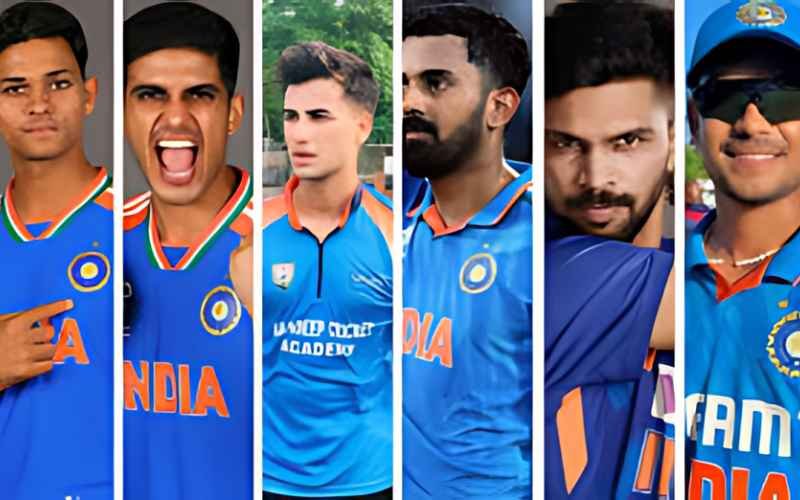India’s T20 cricket landscape is poised for a significant transformation as stalwarts Rohit Sharma and Virat Kohli approach the twilight of their illustrious careers. The duo, who have been the bedrock of India’s batting in T20 Internationals, have set benchmarks with their consistency, leadership, and match-winning performances. However, as the cricketing world evolves, the Indian selectors face the daunting task of identifying the next generation of cricketers who can fill the void left by these legends.

The Legacy of Rohit and Kohli
Rohit Sharma and Virat Kohli have not only been prolific run-scorers but also captains who have shaped the team’s ethos. Rohit, with his impeccable timing and ability to pace an innings, and Kohli, with his aggressive yet technically sound approach, have created memories that fans cherish. Their contributions have been pivotal in India’s success across various formats, especially in T20Is, where the margin for error is minimal.
The Emerging Contenders
As India looks beyond Rohit and Kohli, several young talents have showcased their potential in domestic cricket and the Indian Premier League (IPL). Here are a few names that could be the future of India’s T20 batting line-up:
1. Shubman Gill
Shubman Gill has already made a mark in Test and ODI cricket with his elegant stroke play and composure at the crease. His ability to anchor an innings while maintaining a healthy strike rate makes him a strong contender for the opening slot in T20Is.
2. Ishan Kishan
Ishan Kishan’s aggressive batting style and flexibility to play anywhere in the top order provide a dynamic option for the team. His left-handedness adds variety to the batting line-up, and his experience in IPL high-pressure situations bodes well for his international prospects.
3. Prithvi Shaw
Prithvi Shaw’s explosive batting can dismantle any bowling attack on his day. Known for his fearless approach, Shaw has the potential to give India quick starts, a quality that is invaluable in T20 cricket.
4. Sanju Samson
Sanju Samson’s flair and ability to play innovative shots make him a valuable asset in the middle order. His leadership experience with the Rajasthan Royals in the IPL adds to his credentials as a future leader.
5. Ruturaj Gaikwad
Ruturaj Gaikwad’s consistency and technique have been impressive in the IPL. He has shown maturity beyond his years and could be groomed to take on a significant role in the T20 side.
The Leadership Question
Replacing the batting prowess of Rohit and Kohli is one challenge; finding a leader with their vision and tactical acumen is another. KL Rahul and Rishabh Pant are among the frontrunners for the captaincy role, given their experience and leadership stints in the IPL. However, nurturing a young leader who can grow into the role might be a long-term strategy the selectors consider.
The Road Ahead
The transition phase will require patience and strategic planning. The Indian cricket board and selectors will need to provide ample opportunities for these young players to prove their mettle. Building a cohesive unit that can perform consistently at the international level will be crucial.
As India prepares for future T20 World Cups, the focus will be on creating a balanced team that can adapt to different conditions and handle the pressures of international cricket. The legacy of Rohit Sharma and Virat Kohli will be challenging to emulate, but with the right blend of talent and guidance, India can hope to maintain its dominance in the T20 format.
The coming years promise excitement and anticipation as fans watch the new era of Indian T20 cricket unfold, hoping for the emergence of heroes who can carry forward the legacy of their predecessors.
Top 20 FAQs About India’s T20 Cricket Transition
- Who are the top contenders to replace Rohit Sharma in T20Is?
- Shubman Gill, Ishan Kishan, and Prithvi Shaw are among the leading contenders. Shubman Gill is known for his elegant stroke play, while Ishan Kishan brings aggression and versatility. Prithvi Shaw offers explosive batting at the top. Each player has shown promise in domestic cricket and the IPL.
- Which players are likely to fill Virat Kohli’s shoes in T20Is?
- Potential replacements for Virat Kohli include Sanju Samson and Ruturaj Gaikwad. Samson’s flair and innovative shots make him a valuable middle-order asset. Gaikwad’s consistency and technique have impressed in the IPL. Both players are seen as future stars.
- Who might be the next captain of the Indian T20 team?
- KL Rahul and Rishabh Pant are frontrunners for the captaincy role. Rahul has experience leading in the IPL and has been a consistent performer. Pant’s leadership with the Delhi Capitals and his fearless batting style make him a strong candidate. The selectors might also consider grooming a young leader for the future.
- What qualities are the selectors looking for in the new players?
- Selectors are looking for players with consistency, adaptability, and the ability to perform under pressure. Technical soundness and a high strike rate are crucial in T20 cricket. Leadership potential and the ability to gel with the team dynamics are also important. Young players must show they can handle international cricket’s demands.
- How important is IPL performance for selection in T20Is?
- IPL performance is a significant factor in T20I selection. The IPL provides a platform for players to perform under pressure and against top international talent. Success in the IPL often translates to confidence and readiness for international cricket. Consistent IPL performers are closely watched by selectors.
- Can Shubman Gill adapt to the T20 format?
- Shubman Gill has shown adaptability across formats, excelling in Tests and ODIs. His ability to anchor innings while maintaining a good strike rate is an asset. Gill’s composure and technique make him well-suited for the T20 format. His IPL experiences have further honed his skills for T20 cricket.
- What makes Ishan Kishan a strong contender for the opening slot?
- Ishan Kishan’s aggressive batting style and flexibility are key strengths. His left-handedness adds variety to the batting line-up. Kishan’s experience in high-pressure IPL situations enhances his credentials. His ability to give quick starts is invaluable in T20 cricket.
- How does Prithvi Shaw’s playing style benefit the team?
- Prithvi Shaw’s explosive batting can dismantle any bowling attack. His fearless approach provides quick starts, putting pressure on the opposition. Shaw’s aggressive intent aligns with T20 cricket’s demands. His domestic and IPL performances showcase his potential.
- What role can Sanju Samson play in the T20 team?
- Sanju Samson brings flair and innovative shot-making to the middle order. His experience as an IPL captain adds leadership value. Samson’s ability to play under pressure and adapt to different situations is crucial. He offers both stability and explosiveness when needed.
- How important is Ruturaj Gaikwad’s consistency for his selection?
- Ruturaj Gaikwad’s consistency has been impressive in the IPL. His technique and ability to build innings make him a strong contender. Gaikwad’s maturity beyond his years is a valuable asset. His performances have shown he can handle the rigors of international cricket.
- What challenges do new players face when replacing legends like Rohit and Kohli?
- New players face the pressure of living up to high expectations. They must adapt quickly to international standards and team dynamics. Consistency and performing under pressure are critical. Balancing personal performance with team needs is a challenge.
- How can KL Rahul’s experience benefit the team?
- KL Rahul’s experience in international cricket and the IPL is invaluable. His leadership skills and calm demeanor are assets. Rahul’s versatility to play different roles adds flexibility. His experience can guide younger players in the transition phase.
- What makes Rishabh Pant a potential leader for the T20 team?
- Rishabh Pant’s fearless batting and dynamic style are key strengths. His leadership with Delhi Capitals shows his potential as a captain. Pant’s ability to remain calm under pressure is crucial. His energy and positivity can inspire the team.
- How does the selection process work for T20I replacements?
- The selection process involves evaluating domestic and IPL performances. Consistency, adaptability, and fitness are key criteria. Selectors also consider players’ ability to handle international pressure. Team dynamics and future potential are factored in.
- What is the role of domestic cricket in grooming future T20I players?
- Domestic cricket provides a platform for players to develop skills and gain experience. Consistent domestic performances can lead to IPL opportunities. It allows players to adapt to different playing conditions. Domestic success builds confidence for international cricket.
- Can young players handle the pressure of replacing legends?
- Young players must demonstrate mental toughness and resilience. Support from experienced teammates and coaches is crucial. Exposure to high-pressure situations in IPL helps. Confidence and self-belief are key to handling the pressure.
- How do selectors balance experience and youth in the team?
- Selectors aim for a balanced mix of experience and youth. Experienced players provide stability and mentorship. Young talents bring energy and new perspectives. The right blend is crucial for team success.
- What impact will the transition have on the team’s performance?
- The transition may initially bring challenges and inconsistencies. Patience and strategic planning are essential. Building a cohesive unit takes time. The goal is long-term success and maintaining competitiveness.
- How can fans support the team during this transition phase?
- Fans can show patience and trust in the selectors’ decisions. Supporting young players and acknowledging their efforts is important. Constructive feedback and positive encouragement help. Understanding the process of building a new team is key.
- What are the future prospects for Indian T20 cricket?
- The future is promising with a pool of talented young players. Strategic planning and proper grooming will yield results. Maintaining India’s dominance in T20 cricket is the goal. Fans can look forward to exciting times ahead with emerging stars.






